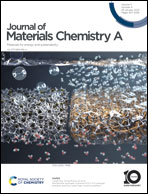Photocatalytic generation of H2O2 over a Z-scheme Fe2O3@C@1T/2H-MoS2 heterostructured catalyst for high-performance Fenton reaction†
Abstract
The wide application of the Fenton reaction has been severely restricted by the requirement of continuous feeding of H2O2, the iron-slurry production, and the slow recycle rate of Fe3+/Fe2+. This work reports transforming type-II Fe2O3@2H-MoS2 heterostructures to a Z-scheme Fe2O3@C@1T/2H-MoS2 catalyst capable of photocatalytic in situ generation of H2O2 as an oxidant for the subsequent Fenton reaction. With MoS2 as a co-catalyst to improve the reduction from Fe3+ to Fe2+, the cascade process demonstrates high performance in oxidative degradation of organics (e.g., 100 mg L−1 tetracycline within 100 min). The in situ generated H2O2, with a yield as high as 1575 μmol g−1 h−1 in air-saturated methanol solution (75 vol%), accounts for 43.5% of the total degradation efficiency. The current system represents an effective solution to the challenges in the traditional Fenton reaction, holding great potential for organic pollutant degradation in wastewater.



 Please wait while we load your content...
Please wait while we load your content...